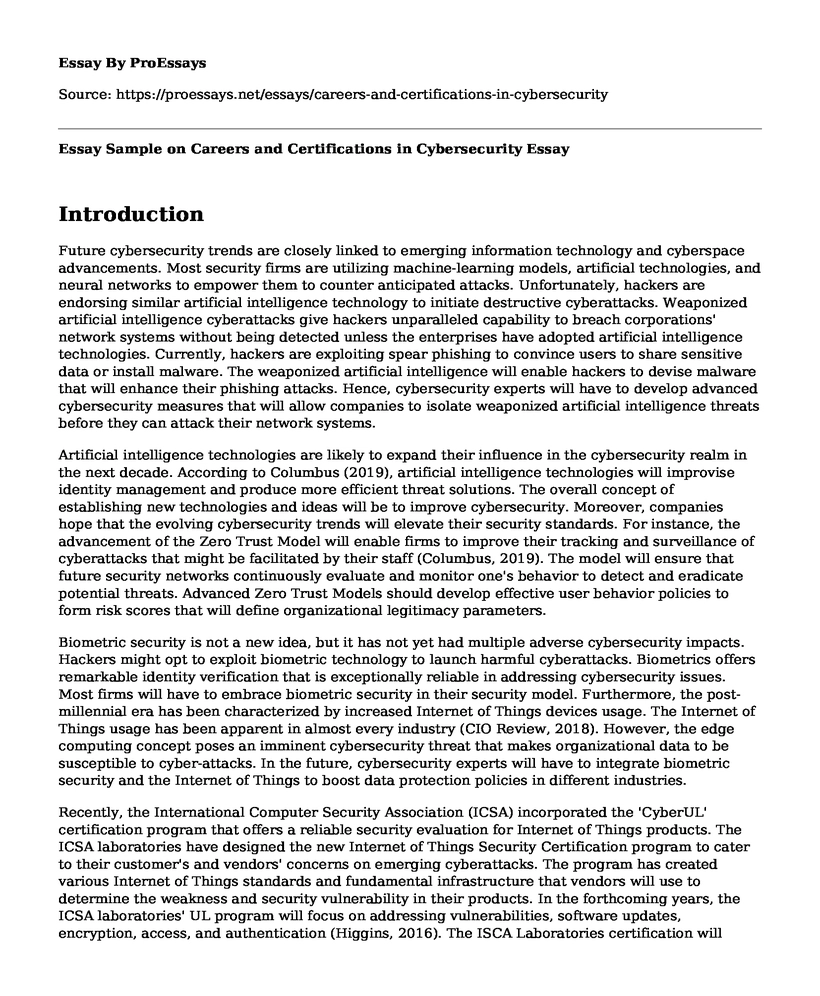Introduction
Future cybersecurity trends are closely linked to emerging information technology and cyberspace advancements. Most security firms are utilizing machine-learning models, artificial technologies, and neural networks to empower them to counter anticipated attacks. Unfortunately, hackers are endorsing similar artificial intelligence technology to initiate destructive cyberattacks. Weaponized artificial intelligence cyberattacks give hackers unparalleled capability to breach corporations' network systems without being detected unless the enterprises have adopted artificial intelligence technologies. Currently, hackers are exploiting spear phishing to convince users to share sensitive data or install malware. The weaponized artificial intelligence will enable hackers to devise malware that will enhance their phishing attacks. Hence, cybersecurity experts will have to develop advanced cybersecurity measures that will allow companies to isolate weaponized artificial intelligence threats before they can attack their network systems.Artificial intelligence technologies are likely to expand their influence in the cybersecurity realm in the next decade. According to Columbus (2019), artificial intelligence technologies will improvise identity management and produce more efficient threat solutions. The overall concept of establishing new technologies and ideas will be to improve cybersecurity. Moreover, companies hope that the evolving cybersecurity trends will elevate their security standards. For instance, the advancement of the Zero Trust Model will enable firms to improve their tracking and surveillance of cyberattacks that might be facilitated by their staff (Columbus, 2019). The model will ensure that future security networks continuously evaluate and monitor one's behavior to detect and eradicate potential threats. Advanced Zero Trust Models should develop effective user behavior policies to form risk scores that will define organizational legitimacy parameters.
Biometric security is not a new idea, but it has not yet had multiple adverse cybersecurity impacts. Hackers might opt to exploit biometric technology to launch harmful cyberattacks. Biometrics offers remarkable identity verification that is exceptionally reliable in addressing cybersecurity issues. Most firms will have to embrace biometric security in their security model. Furthermore, the post-millennial era has been characterized by increased Internet of Things devices usage. The Internet of Things usage has been apparent in almost every industry (CIO Review, 2018). However, the edge computing concept poses an imminent cybersecurity threat that makes organizational data to be susceptible to cyber-attacks. In the future, cybersecurity experts will have to integrate biometric security and the Internet of Things to boost data protection policies in different industries.
Recently, the International Computer Security Association (ICSA) incorporated the 'CyberUL' certification program that offers a reliable security evaluation for Internet of Things products. The ICSA laboratories have designed the new Internet of Things Security Certification program to cater to their customer's and vendors' concerns on emerging cyberattacks. The program has created various Internet of Things standards and fundamental infrastructure that vendors will use to determine the weakness and security vulnerability in their products. In the forthcoming years, the ICSA laboratories' UL program will focus on addressing vulnerabilities, software updates, encryption, access, and authentication (Higgins, 2016). The ISCA Laboratories certification will ensure that cybersecurity weaknesses are fixed and the continuous tests will guarantee that weaponized artificial intelligence threats are discovered.
Conclusion
Future cybersecurity trends are interrelated to evolving information technology and cyberspace advancements. Weaponized artificial intelligence cyberattacks give hackers a unique ability to breach corporations' network systems without being detected unless the targeted enterprises have integrated artificial intelligence technologies. Cybersecurity experts will have to develop advanced cybersecurity measures that will allow companies to isolate weaponized artificial intelligence threats before they can attack their network systems. Advanced Zero Trust Models should establish an effective user behavior policy to form risk scores that define organizational legitimacy parameters. In the future, cybersecurity experts will have to incorporate biometric security and the Internet of Things to boost the security network systems in various industries. The ISCA Laboratories certification will ensure that cybersecurity weaknesses are fixed and the continuous tests will guarantee that weaponized artificial intelligence threats are discovered.References
CIO Review. (2018). Future trends in the cybersecurity industry. Retrieved from https://www.cioreview.com/news/future-trends-in-cybersecurity-industry--nid-27685-cid-145.html
Columbus, L. (2019). Why AI is the future of cybersecurity. Retrieved from https://www.forbes.com/sites/louiscolumbus/2019/07/14/why-ai-is-the-future-of-cybersecurity/#425be3a4117e
Higgins, K. (2016). New internet of things security-certification program launched. Retrieved from https://www.darkreading.com/iot/new-internet-of-things-security-certification-program-launched/d/d-id/1325676
Cite this page
Essay Sample on Careers and Certifications in Cybersecurity. (2022, Mar 02). Retrieved from https://proessays.net/essays/careers-and-certifications-in-cybersecurity
If you are the original author of this essay and no longer wish to have it published on the ProEssays website, please click below to request its removal:
- GoPro Inc and VR Headsets
- Theories That Shape the Challenge of Cybercrime - Essay Example
- Security of Electronic Devices Essay
- QSEN Pre-Licensure Essay
- Adoption of New Technology Systems: Rogers Theory Paper Example
- Essay Sample on Cyber Terrorism
- Essay Sample on Strategic Leadership and Big Data Phenomenon







